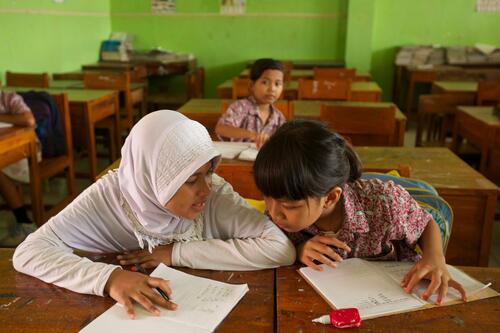“Indonesia Envisions More Religion in Schools”

"Indonesia Envisions More Religion in Schools"
In “Indonesia Envisions More Religion in Schools,” Sara Schonhardt analyzes a proposal of religious educational curriculum reform in Indonesia. The article from the New York Times was written in and addresses a proposal from 2013.
The curriculum change offered a merger of science and social studies with other classes in an effort to create greater space for religious curriculum. Proponents of the proposal claimed to be targeting a ,“lack of moral development,” which had, “led to an increase in violence and vandalism among youths, and that could fuel social unrest and corruption in the future.” Advocates tied this need for greater emphasis on character development with a recent spike in violence of religious motivation. Officials claimed that public feedback they received supported the changes, but showed concern regarding the resource-capability to enact the changes effectively. However, this feedback was never made public and as a result, these specific findings remained unclear in legitimacy. While religious education was already a compulsory subject, the proposal, among its various amendments, intended to double weekly religious schooling time from two to four hours. Backlash to the proposed changes were primarily two-fold. Some criticism centered on concern of global competitiveness and future career-readiness. Other criticism targeted the ignorance of the need for systematic educational reform. These critics highlighted the significant gaps in resource and instructional quality, especially on a globally comparative scale. They feared that the money invested into this effort, which reached about U.S.$18 million, would be wasted if not allocated toward systemic change in Indonesia’s educational infrastructure.
Several parallels appeared in this article with our recent reading, “Spiritual Economies: Islam and Neoliberalism in Contemporary Indonesia,” which was written in 2009 and addresses efforts to integrate religious ethics and spiritual reform into the workplace. A key point in this reading was the intersection between work, worship, and individual ethical transformation. This directly correlates with public official perspective on religious education as a means to improve moral development among students. Rudnyckyj, in the reading on spiritual economies, finds that, “proponents of spiritual reform consider the separation of religious ethics from economic practice as the root of Indonesia’s economic crisis because this disjunction resulted in rampant corruption, inefficiency, and a lack of discipline at the workplace.” While addressing different communities and platforms (the workplace and workers versus schools and students), both “Spiritual Economies…” and “Indonesia Envisions…” present Indonesian viewpoints which postulate a causation between an insufficient level of religious teaching with societal flaws of lack of ethics and character development.
In the New York Times article, Schonhardt presents two contrasting beliefs regarding the proposal which coalesce in a desire for modernization and societal improvement. The public officials in support of curriculum reform desire to rectify an apparent absence of character development in schooling which they connect to societal flaws such as increased violence. Some of those who oppose the proposal, however, reject it due to a fear of falling further behind competing countries in productivity and advancement. Both of these aims seem to align with a neoliberal framework for modernization, simply with different focuses either on individual ethical refinement or financial-occupational improvement.
Ultimately, it seems clear that Indonesia views modernization as the primary concern in determining the most pressing needs of institutional change. Among many people, religion is seen as a tool to accomplish this, running against the Western standard for modernization. This non-Western disjunction seems clear in Schondhardt’s tone which seems doubtful, if not critical, of the religious approach to education reform. To be fair, these doubts are also well-founded considering local resistance rooted in desire for systemic change, against the curricular change proposals. Indonesia, again, emerges as an epicenter for modernization and Western-clashing strategies to achieve it.
Sources
https://www.nytimes.com/2013/01/07/world/asia/in-indonesia-science-may-give-way-to-religion.html
Comments
Ryan,
This is a really fine analysis of the intersection of religion and modernization in Indonesia, and your connection to the Spiritual Economies reading is very well done.
My only quibble is that given the powerful influence of religious conservatives in the US of A, I am not sure that your notion of the “Western standard for modernization” being opposed to religion actually holds up. The US may be more like Indonesia in this respect than many of us realize. In many ways, this gives us more reason to study and learn from places like Indonesia.
Pages